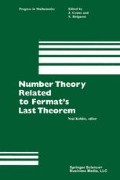Abstract
In studying geometry of Fermat varieties, there are two basic facts. One is readily visible (and hence a well-known) fact that a large finite group of automorphisms acts on a Fermat variety. The other is the existence of the so-called “inductive structure” of Fermat varieties of a fixed degree. By combining these, we can deal with various geometric questions concerning Fermat varieties and their products (or varieties closely related to them) such as the Hodge Conjecture [1] or the Tate Conjecture [11].
Access this chapter
Tax calculation will be finalised at checkout
Purchases are for personal use only
Preview
Unable to display preview. Download preview PDF.
References
Deligne, P. “Hodge Cycles on Abelian Varieties,” in Hodge Cyoless Motives, and Shimura Varieties, Springer LNM 900, 1982.
Hodge, W.V.D. “The Topological Invariants of Algebraic Varieties,” Proc. Int. Congr. Math. (1950), 182–192.
Pohlmann, H. “Algebraic Cycles on Abelian Varieties of Complex Multiplication Type,” Ann. of Math. 88 (1968), 161–180.
Ran, Z. “Cycles on Fermat Hypersurfaces,” Compositio Math. 42 (1980), 121–142.
Rohrlich, D. “The Periods of the Fermat Curve, Appendix to H. Gross’ Paper,” Inventiones Math. 45, (1978), 193–211.
Shioda, T. and Katsura, T. “On Fermat Varieties,” Tohoku Math. J. 31 (1979), 97–115.
Shioda, T. “The Hodge Conjecture for Fermat Varieties,” Math. Ann. 245 (1979), 175–184.
Shioda, T. “The Hodge Conjecture and the Täte Conjecture for Fermat Va riet ies,” Proc. Japan Acad. 55, (1979), 111–11 4.
Shioda, T. “Algebraic Cycles on Abelian Varieties of Fermat Type,” Math. Ann. 258 (1981), 65–80.
Shioda, T. “On the Picard Number of a Fermat Surface,” J. Fac. Sei. Univ. Tokyo, See. IA, 28 (1982), 725–734.
Shioda, T. “What is Known About the Hodge Conjecture?”, in Proc. of Symposium on Algebraic Varieties and Analytic Varieties (he 1d at Univ. Tokyo, July 1981), to appear.
Täte, J. “Algebraic Cycles and Poles of Zeta Functions,” in Arithmetical Algebraic Geometry, Harper and Row, (1965), 93–110.
Weil, A. “Number of Solutions of Equations in Finite Fields,” Bull. Amer. Math. Soc. 55 (1949), 497–508.
Weil, A. “Jacobi sums as 1Grössencharaktere’,” Trans. Amer. Math. Soc. 73 (1952), 487–495.
Author information
Authors and Affiliations
Editor information
Editors and Affiliations
Rights and permissions
Copyright information
© 1982 Springer Science+Business Media New York
About this chapter
Cite this chapter
Shioda, T. (1982). Geometry of Fermat Varieties. In: Koblitz, N. (eds) Number Theory Related to Fermat’s Last Theorem. Progress in Mathematics, vol 26. Birkhäuser, Boston, MA. https://doi.org/10.1007/978-1-4899-6699-5_3
Download citation
DOI: https://doi.org/10.1007/978-1-4899-6699-5_3
Publisher Name: Birkhäuser, Boston, MA
Print ISBN: 978-0-8176-3104-8
Online ISBN: 978-1-4899-6699-5
eBook Packages: Springer Book Archive

